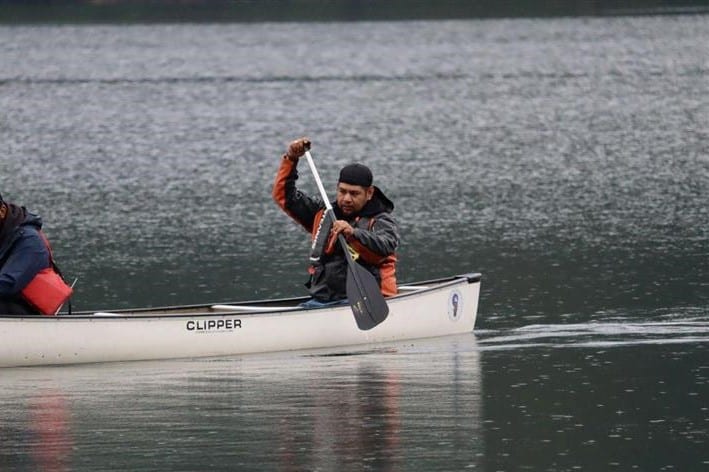By Craig Stephani | July 26, 2023
When Natasha Cook heard about our series featuring members of the Indigenous Invasive Species Network (IISN), she immediately knew who to tell us about! Natasha is a member of the Katzie First Nation. She works as Operations Assistant for the Katzie Development Limited Partnership (KDLP) and she’s a new member of the Indigenous Invasive Species Network. Before joining the economic development firm owned and operated by the Katzie First Nation, Natasha says she didn’t have much invasive species knowledge. But she’s since learned a lot, quickly recognizing the impact even small actions can make for the animals and ecosystems in her community.
Today, the world of invasive species is a big part of her work. And in the next installment of our series featuring members of the IISN, Natasha introduces us to Burgess Pierre, well known in the community for his work ethic and willingness to teach the Nation’s youth about the world around them. Meet Burgess Pierre!
Member Spotlight: Burgess Pierre

Burgess Pierre is a proud Member of the Katzie First Nation who enjoys spending time in his Nation’s traditional territories – especially by boat. On any given day, you might find him canoeing down Widgeon Slough, fishing on the Fraser River or hiking around Alouette Lake.
It was during time spent connecting with nature in his local environment that Burgess got clear, firsthand insight into the impact of invasive species. He witnessed the challenges posed by White-tailed deer (a species not native to the area) and fallow deer (an invasive species in BC), competing with native species for vital resources like food, water, and wintering areas. He was also running into invasive species at work.
“While participating in various assessments, I have further understood the biodiversity of multiple watersheds and how they [native species] are heavily impacted by invasive species infestations. Not only plants, but everything within the area: insects, amphibians, birds, small/large mammals.”
Burgess is a Crew Lead and Senior Field Technician with KDLP, where he has been working for around a decade. Burgess’s journey into the realm of invasive species began early in his career when he took part in numerous projects focused on surveying of salmonids and identifying invasive fish. It was here that he saw many different types of invasive fish throughout the Alouette Watershed.
And although he has an affinity to water, he also restores the natural balance on land.
“I have for the last three years been fortunate enough to lead multiple crews in removing invasive blackberry from both Widgeon Provincial Park and Widgeon Valley National Wildlife Area for the Environment and Climate Change Canada’s Canadian Wildlife Service.”
Burgess lists some of the challenges and obstacles that he faces while managing invasive species. These include:
- accessing sites using canoes in inclement weather,
- unstable streambanks limiting access to work areas,
- bees’ nests, ant hills, mosquito and tick bites, and
- wildlife usage of the area, including nesting birds, beavers utilizing the area, high traffic game trails and predator kill sites.
“The only way to address these situations is to heavily plan and mitigate dangerous activities, or completely avoid entering the treatment site.”
“My connection to the land has allowed me to develop and follow a safe work procedure which outlined the best management practices for removal of invasive blackberry.”

There are also other considerations like reducing archeological impacts by minimizing ground disturbance (<15cm) and even calculating damage to the site during the removal process vs. the damage being done by the invasive species.
“I have understood and witnessed how dense invasive plants/animals prevent the establishment of native shrubs (i.e., Salmon berry), limits food sources, [provides] little to no habitat for nesting birds and little to no cover for small/large mammals.”
“The relationship between invasive species and preservation of Indigenous knowledge has given me a chance to identify, inventory and monitor problematic and treatable areas within the Katzie First Nation Territory. I have been able to document all the information and supply my Nation with an action plan to involve Nation Members in treatment of invasive plants and to provide the knowledge of what plants are significant to Our Culture and how participation can help further understanding of native plant species.”
Burgess believes that Indigenous knowledge and practices are vital to the successful management and prevention of invasive species. Integrating traditional wisdom with scientific approaches can yield comprehensive solutions to combat invasive species effectively. When it comes to the success of any invasive species management initiative and the roles of Indigenous peoples in the process, Burgess says:
“Be a part of the entire process of best management practices and continuously monitor the progress, get out and get dirty!”
For those aspiring to get involved in invasive species management and land stewardship, Burgess offers valuable advice.
“Set yourself achievable goals along your journey, enjoy your time out in the field and share your story with others. You may be the one inspiring the next generation.”
Burgess is a true guardian of the land. He leads by example, demonstrating how one person’s dedication can lead to positive change.
Inspired by his call to “Stop, Watch, Listen, Learn, Share, and Teach,” we deepen our resolve to steward the natural treasures around us, weaving together science, tradition, and community to prevent the spread of invasive species.
We share Burgess’ story as part of a series introducing members of ISCBC’s Indigenous Invasive Species Network (IISN), showcasing their outstanding work, unique approaches and highlighting their contributions. Through their stories, we hope to inspire others and foster a greater understanding of the vital role Indigenous peoples play in addressing this global challenge.
We invite all Indigenous people, communities, and Indigenous-led organizations to join ISCBC’s Indigenous Invasive Species Network. Together, we can amplify Indigenous voices, share knowledge, and develop innovative solutions to combat invasive species. By working together, we can build and steward healthy landscapes, including habitats and communities, free of invasive species.
Craig is an Outreach Lead at ISCBC. He is passionate about sharing his excitement for nature with others. In his spare time, he enjoys hiking, camping and exploring wild areas near and far. You can reach Craig at cstephani@bcinvasives.ca
Share





